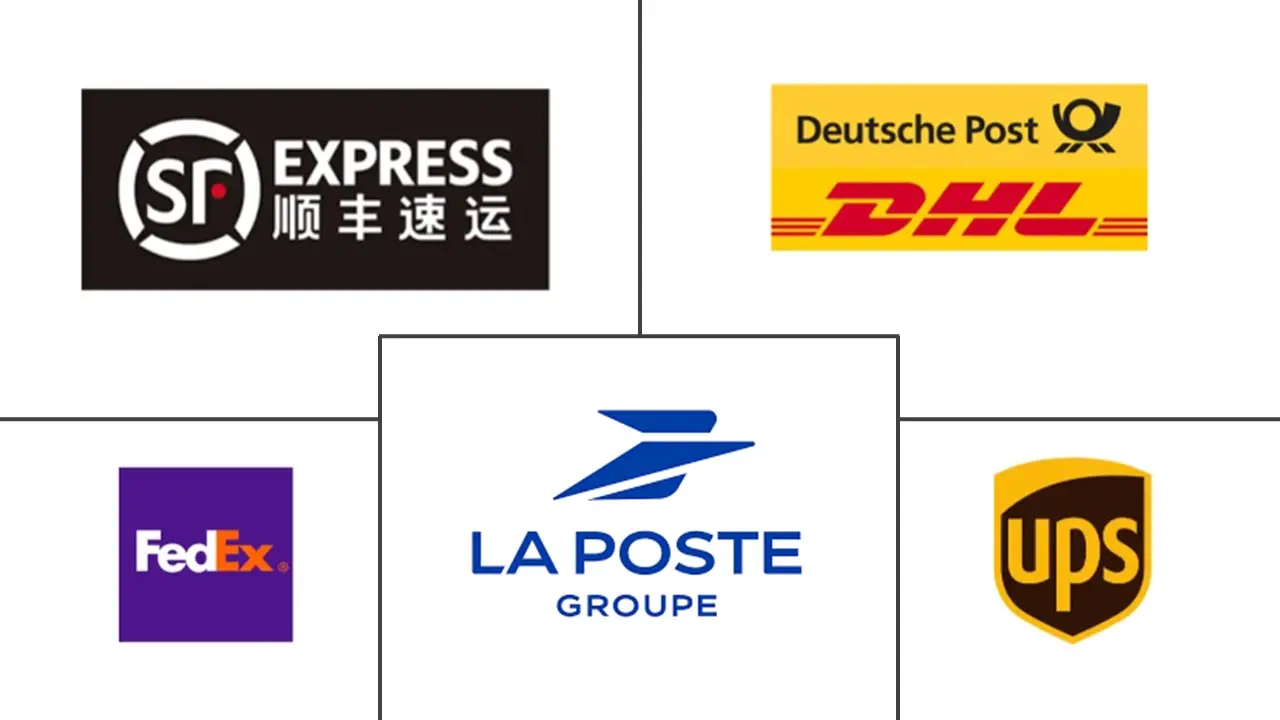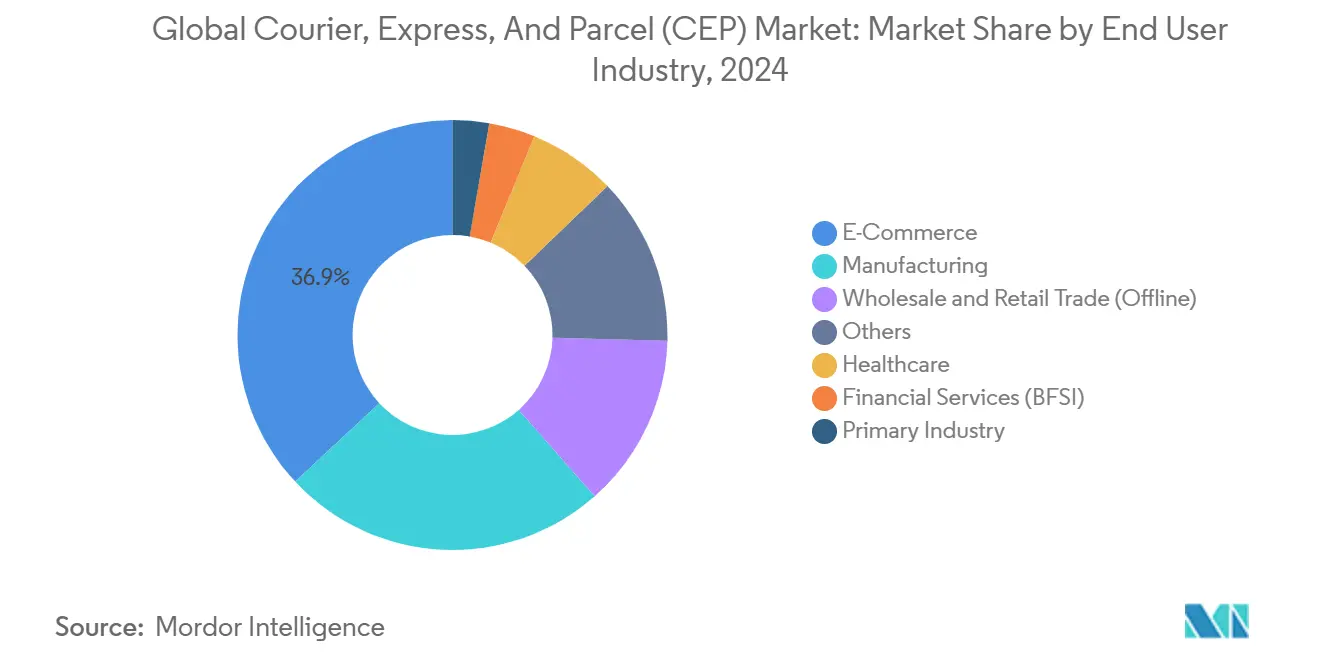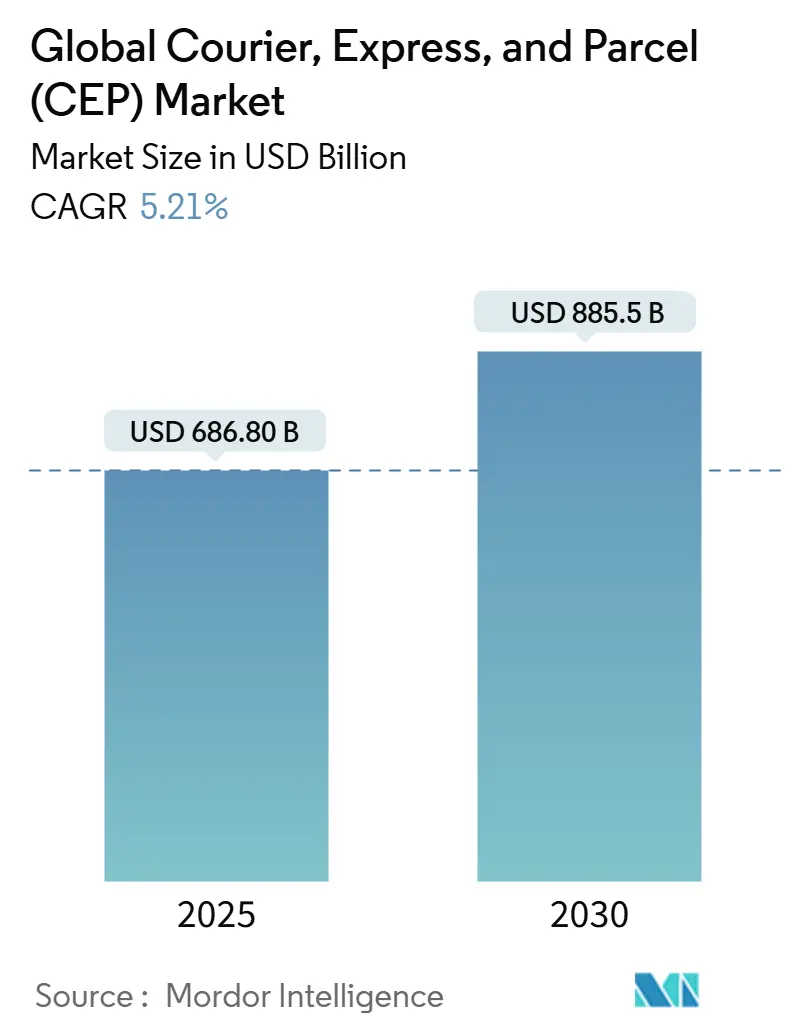
Courier, Express, And Parcel (CEP) Market Analysis by Mordor Intelligence
The courier express parcel market generated USD 686.8 billion in 2025 and is forecast to reach USD 885.5 billion by 2030, advancing at a 5.21% CAGR between 2025-2030. This outlook signals a transition from the pandemic-era surge toward steadier expansion led by premium services, network automation, and selective capacity additions. E-commerce remains the core volume engine, yet operators now emphasize margin protection through dynamic pricing, technology-enabled routing, and value-added verticals such as healthcare logistics. Cross-border flows are expanding as more small and medium exporters rely on digital marketplaces, while domestic volumes plateau in mature regions. Capital continues gravitating to digital-first networks able to integrate air capacity, regional road fleets, and out-of-home delivery points to optimize cost and speed. Consolidation, highlighted by DSV’s purchase of DB Schenker, underlines the strategic value of scale as labor shortages, fuel-neutral fleets, and air-freight constraints raise operating thresholds.
Key Report Takeaways
- By destination, international parcels grew at 5.57% CAGR between 2025-2030, and domestic parcels accounted for 69.09% of the 2024 courier express parcel market share.
- By model, business-to-consumer (B2C) shipments led with 47.72% revenue share in 2024; consumer-to-consumer (C2C) volumes are projected to expand at 6.43% CAGR between 2025-2030.
- By shipment weight, light weight shipments under 5 kg represented 61.97% of the 2024 courier express parcel market share, whereas medium weight shipments between 5 kg and 31.5 kg are set to rise at 7.06% CAGR between 2025-2030.
- By shipment speed, non-express services captured 63.13% of the courier express parcel market size in 2024, and express services are advancing at a 6.00% CAGR between 2025-2030.
- By mode of transport, road transport held 48.49% of revenue in 2024, while air freight exhibits the fastest 5.66% growth rate between 2025-2030.
- By end user industry, healthcare contributed the highest growth at 5.75% CAGR between 2025-2030, supported by temperature-controlled distribution demand; e-commerce captured the largest market share at 36.94% in 2024.
- By geography, North America commanded 36.76% revenue share in 2024, while Asia-Pacific is projected to expand at a 6.77% CAGR between 2025-2030.
Global Courier, Express, And Parcel (CEP) Market Trends and Insights
Drivers Impact Analysis
| Driver | (~) % Impact on CAGR Forecast | Geographic Relevance | Impact Timeline |
|---|---|---|---|
| E-commerce penetration in emerging Asia-Pacific | +1.8% | Asia-Pacific, spill-over to MEA | Medium term (2-4 years) |
| Cross-border SME exports via digital platforms | +0.9% | Europe and North America | Long term (≥ 4 years) |
| Same-day delivery premiumization | +0.7% | North America urban centers | Short term (≤ 2 years) |
| GCC postal-network modernization | +0.4% | Middle East and Africa | Medium term (2-4 years) |
| Out-of-home PUDO adoption in Nordics | +0.3% | Europe | Medium term (2-4 years) |
| Cold-chain compliance for healthcare parcels | +0.6% | Developed markets, led by Japan | Long term (≥ 4 years) |
Source: Mordor Intelligence
E-commerce Penetration Driving B2C Parcel Volumes in Emerging Asia-Pacific
Smartphone-led shopping now drives parcel demand as 57% of online buyers purchase via mobile devices. Cross-border volumes climb in tandem with social-commerce sales, projected at USD 8.5 trillion by 2030. China’s cross-border parcel flows grew alongside a RMB 21.4 trillion (USD 3.01 trillion) digital-retail sector in 2025, prompting operators to deploy flexible hubs that manage varied package profiles. Network investments across Southeast Asia target wider rural reach and delivery-time certainty, ensuring service parity with urban markets.
Cross-Border SME Exports Leveraging Digital Marketplaces in Europe
European SMEs increasingly ship direct to global customers through online marketplaces, intensifying demand for harmonized customs clearance. Negotiations among 90 WTO members seek common e-commerce rules to reduce procedural friction[1]“World Trade Organization Joint Statement Initiative,” WTO, wto.org. Automated declarations and blockchain-backed documents can cut average trade costs by 11%[2]Asian Development Bank, “Asia-Pacific Trade Facilitation Report 2024,” adb.org. Standardized cross-border services enable operators to pool volumes, lower unit costs, and enlarge the courier express parcel market.
Same-Day Delivery Premiumization in Urban North America
Seventy-eight percent of North American shoppers expect delivery within two days, and many will pay extra for same-day service. Micro-fulfillment hubs within city limits shrink delivery radii, allowing dynamic time-slot pricing. FedEx’s expanded time-definite options illustrate the shift from volume-based growth to service-level differentiation.
Government Push for Postal Network Modernization in GCC Countries
Saudi Arabia’s new logistics hub handling 15,000 boxes daily typifies state-backed upgrades that blend automation and public-private operations. With regional e-commerce expected to rise 10% annually, modernized facilities support scalable courier express parcel market volumes and improve international connectivity.
Restraints Impact Analysis
| Restraint | (≈) % Impact on CAGR Forecast | Geographic Relevance | Impact Timeline |
|---|---|---|---|
| Air-capacity constraints on trans-Pacific lanes | -1.2% | Asia-Pacific to North America | Short term (≤ 2 years) |
| Chronic driver shortage in US and UK | -0.8% | North America and Europe | Medium term (2-4 years) |
| EU delivery-fleet emission caps | -0.5% | Europe, expanding globally | Long term (≥ 4 years) |
| Security risks on Africa’s central corridors | -0.3% | Africa, spill-over to Middle East | Medium term (2-4 years) |
Source: Mordor Intelligence
Air-Capacity Constraints on Trans-Pacific Lanes
Freighter supply rose 8% in 2024, yet demand from China is set to climb 20% in 2025, tightening space and lifting spot rates 15% year-on-year[3]“Capacity Crunch on Trans-Pacific Routes,” Air Cargo News, aircargonews.net. Limited new-aircraft deliveries cap future growth near 4.4%. Operators prioritize high-value goods and explore secondary hubs, but elevated costs weigh on the courier express parcel market CAGR.
Chronic Driver Shortage
The United States alone will need 1.2 million new drivers by 2030, a gap that inflates last-mile wages and churn[4]“Driver Shortage Industry Update 2025,” Bloom Services, bloomtrucks.com. Smaller carriers struggle to match pay packages or fund automation, hastening consolidation toward fleets with resources for electric vans, route-optimizing AI, and employee retention schemes.
Segment Analysis
By End User Industry: Healthcare Logistics Leads
Healthcare recorded the fastest 5.75% CAGR between 2025-2030 as aging populations lift demand for temperature-controlled deliveries. DHL and UPS aim to grow healthcare revenues to USD 10.8 billion and USD 20 billion, respectively, underscoring strategic focus. Real-time data loggers ensure compliance, justifying premium fees embedded within the overall courier express parcel market pricing.
E-commerce still represented 36.94% of 2024 volumes but shows a gradual deceleration in mature regions. Manufacturing and wholesale trade offer steady B2B flows, while financial services shipments decline as digitization reduces physical document exchange.
Note: Segment shares of all individual segments available upon report purchase
By Destination: International Growth Outpaces Domestic Stability
International parcels expanded at 5.57% CAGR between 2025-2030, yet made up 30.91% of the 2024 courier express parcel market volume. The courier express parcel market size tied to cross-border flows is set to widen as trade agreements and electronic customs procedures simplify clearance. Domestic deliveries keep a 69.09% share in 2024, but mature e-commerce penetration caps growth.
Technology-enabled services such as BEST Inc.’s CNY 7 (USD 0.98) per-kilogram offering connect Southeast Asian shoppers to Chinese merchants, illustrating cost reductions through consolidated exports. WTO digital-trade frameworks and RCEP customs harmonization further encourage SMEs to ship internationally, expanding high-margin lanes for established integrators.
By Shipment Speed: Express Premium Retains Pricing Power
Non-Express consignments held a 63.13% share in 2024, and express consignments will grow at 6.00% CAGR between 2025-2030, reflecting customer willingness to pay for speed. The courier express parcel market size attached to express tiers benefits from unified pricing engines that flex surcharges with real-time capacity data. Standard services remain essential for cost-sensitive freight but face margin pressure.
Healthcare and luxury retail customers rely on guaranteed-delivery windows, enabling carriers to capture premium yields. AI-driven routing shrinks delivery windows, increasing vehicle utilization even as urban congestion rises.
By Shipment Weight: Medium Parcels Accelerate
Lightweight shipments under 5 kg dominated 61.97% of shipments in 2024. Yet medium parcels between 5-31.5 kg will rise at 7.06% CAGR between 2025-2030, buoyed by online purchases of home goods and small appliances. Automated sorters now handle variable sizes without manual re-feed, supporting higher throughput.
Smart-packaging adoption aids space utilization and condition monitoring, protecting fragile medium-weight goods while enabling ergonomic loading. Heavy parcels stay niche due to modal competition from LTL trucking, though value-added handling keeps them profitable within the courier express parcel industry.
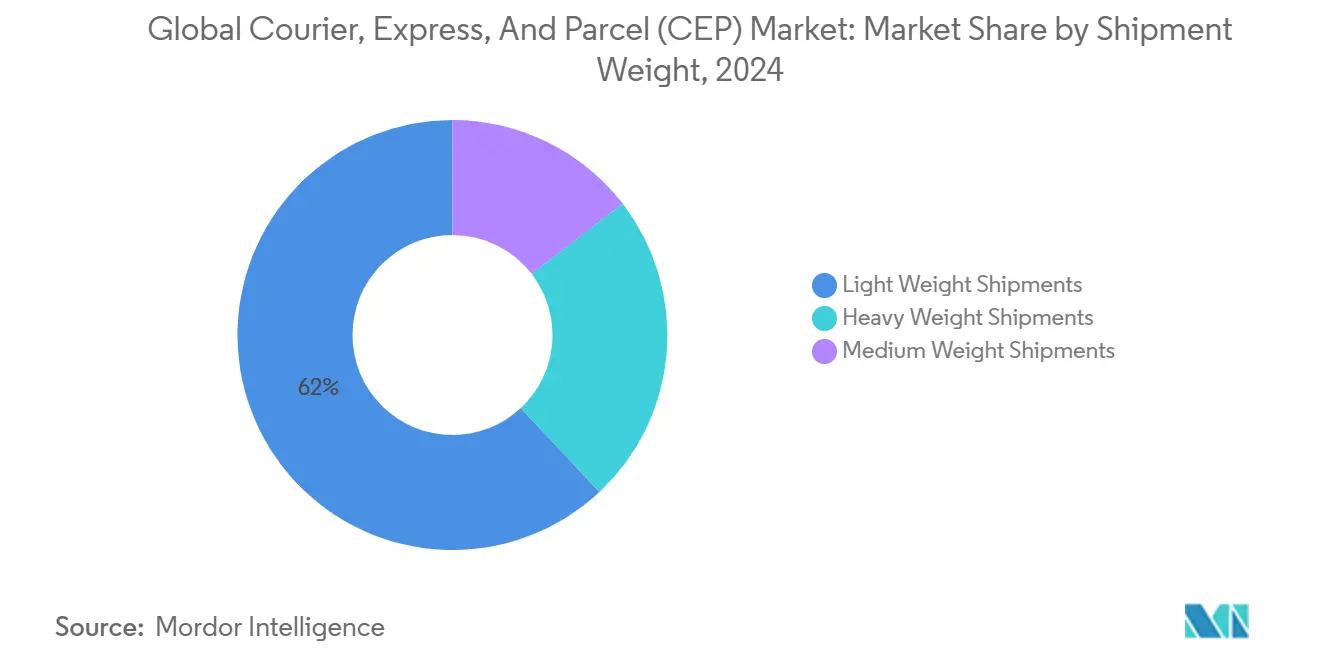
Note: Segment shares of all individual segments available upon report purchase
By Mode of Transport: Air Transport Gains Pace while Road Transport Dominates
Road transport kept a 48.49% share in 2024 through dense national networks and cost advantages on short hauls. Air transport, growing at 5.66% CAGR between 2025-2030, satisfies cross-border e-commerce and high-value merchandise. Integrated carriers hedge capacity via block-space agreements, balancing volatile air-freight rates.
Driver scarcity and city emission regulations drive investment in electric vans, urban bicycles, and autonomous ground units. Air-to-road hand-offs at regional gateways optimize cost-to-serve metrics, reinforcing multimodal agility inside the courier express parcel market.
By Model: Consumer-to-Consumer (C2C) Volume Momentum
Business-to-consumer (B2C) channels retained 47.72% revenue share in 2024, sustaining the largest slice of the courier express parcel market. Consumer-to-consumer (C2C) parcels, however, will grow at 6.43% CAGR between 2025-2030 as resale apps and social platforms proliferate. This evolution demands carrier products that bundle label creation, mobile tracking, and doorstep pickup for individual shippers.
Social-commerce integration blurs traditional B2C and C2C boundaries, pushing carriers to offer hybrid APIs for merchants and private sellers alike. Business-to-business (B2B) shipments remain stable but may cede share as manufacturers move toward direct-to-consumer distribution, altering network mix and asset allocation.
Geography Analysis
North America commanded 36.76% of 2024 revenue, anchored by consumer expectations for two-day delivery and developed last-mile assets. Persistent driver shortages magnify operating costs, prompting automation pilots and the acquisition of healthcare specialists such as UPS-Andlauer to secure growth niches. Urban micro-fulfillment centers and same-day offerings support premium-rate stability even as volume growth moderates.
Asia-Pacific is the fastest-growing region at 6.77% CAGR between 2025-2030, propelled by cross-border e-commerce and rising consumer incomes. China’s RMB 21.4 trillion (USD 3.01 trillion) digital retail base drives parcel density, while RCEP customs alignment lowers friction. Yamato Holdings targets JPY 2-2.4 trillion (USD 0.28-0.33 trillion) revenue by FY2027, embedding carbon-neutral pledges to align with regional sustainability mandates. Europe combines legacy postal infrastructure with aggressive decarbonization policies. The ban on new combustion vans by 2035 accelerates fleet electrification; PostNL plans 100% emission-free Benelux delivery by 2030. DHL’s merger with Evri pools international and domestic strengths to handle more than 1 billion UK parcels per year.
Middle East and Africa benefit from GCC diversification programs. Saudi Arabia’s automated hub exemplifies investments positioning the region as an intercontinental transit bridge. Security risks on central corridors and fragmented infrastructure still temper growth, favoring partnerships with national postal operators that bring local expertise. South America remains smaller but developing customs reforms, such as Brazil’s Remessa Conforme program, improve data quality and compliance, encouraging global platforms to expand cross-border offerings. Currency volatility and patchy road networks require flexible, country-specific approaches.
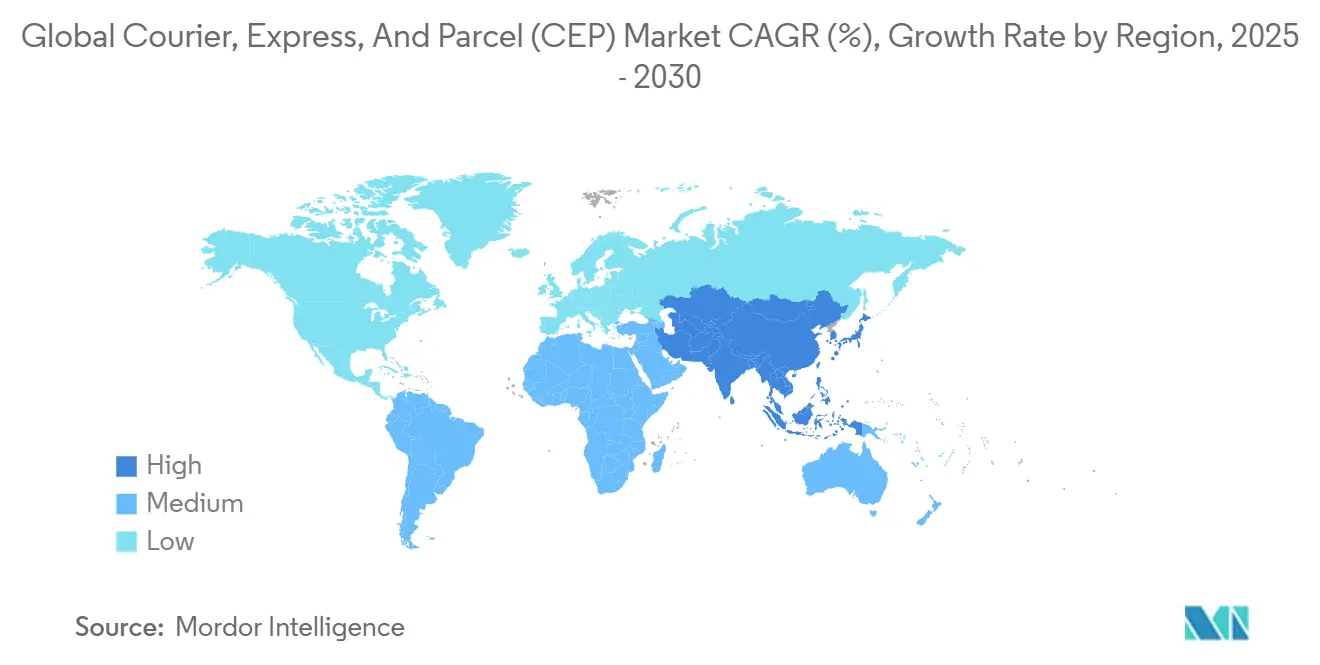
Competitive Landscape
The market is moderately consolidated. DSV’s EUR 14.3 billion (USD 15.78 billion) takeover of DB Schenker elevates combined turnover to EUR 40.3 billion (USD 15.78 billion), creating the largest global forwarder and underscoring the value of scale in the courier express parcel market. Integrated giants like UPS and FedEx leverage premium express portfolios, while regional specialists fortify positions via technology and niche verticals.
Automation, AI routing, and blockchain-enabled visibility distinguish service quality. MDPI research indicates real-time tracking elevates customer satisfaction and reduces disputes. Electric-fleet rollouts comply with tightening emission caps, and autonomous drones and sidewalk robots undergo pilot deployments, though regulatory hurdles slow full adoption.
White-space opportunities persist in cross-border facilitation for SMEs, healthcare cold-chain, and eco-friendly last-mile models. Market consolidation is expected to continue as labor constraints and capital requirements raise competitive entry thresholds.
Courier, Express, And Parcel (CEP) Industry Leaders
-
DHL Group
-
FedEx
-
United Parcel Service of America, Inc. (UPS)
-
SF Express (KEX-SF)
-
La Poste Group (including DPD Group)
- *Disclaimer: Major Players sorted in no particular order
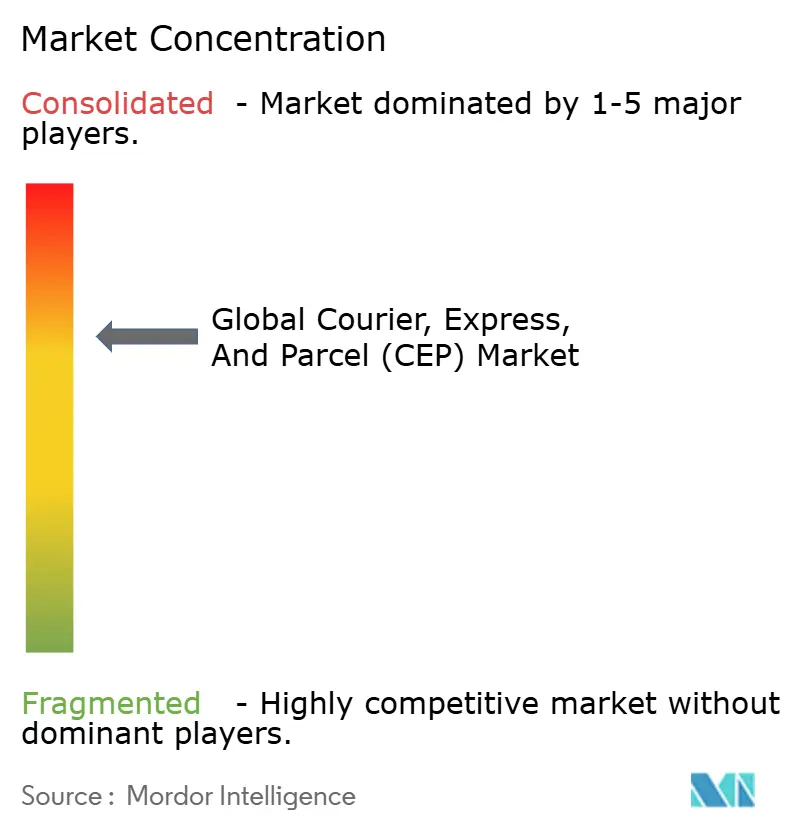
Recent Industry Developments
- June 2025: JD.com launched its first self-operated international express service to compete globally.
- May 2025: DHL eCommerce UK merged with Evri, forming a network delivering over 1 billion parcels annually.
- April 2025: UPS agreed to buy Andlauer Healthcare Group for CAD 2.2 billion (USD 1.6 billion), expanding temperature-controlled capacity.
- April 2025: DSV closed its EUR 14.3 billion (USD 15.78 billion) acquisition of DB Schenker, adding nearly 160,000 employees across 90 countries.
Global Courier, Express, And Parcel (CEP) Market Report Scope
CEP stands as an abbreviation for courier express parcel services that offer logistic services in areas. The offer of the service providers differs in the speed, weight, and volume of the packages and the way of carrying out the shipment of the goods. Especially the regulations regarding weight and volume allow for strong standardization and great potential for automating the service. A complete background analysis of the Courier, Express, and Parcel (CEP) Market, including the assessment of the economy and contribution of sectors in the economy, market overview, market size estimation for key segments, and emerging trends in the market segments, market dynamics, and geographical trends, and COVID-19 impact, is covered in the report.
The Courier, Express, and Parcel (CEP) Market is segmented By Business (B2B, B2C and C2C), Destination (Domestic and International), By End User (Services, Wholesale and Retail Trade, Manufacturing, Construction and Utilities, and Primary Industries), and By Geography (North America, Europe, Asia-Pacific, and Rest of the World). The report offers the market size and forecasts in value (USD) for all the above segments.
| Destination | Domestic | ||
| International | |||
| Speed of Delivery | Express | ||
| Non-Express | |||
| Model | Business-to-Business (B2B) | ||
| Business-to-Consumer (B2C) | |||
| Consumer-to-Consumer (C2C) | |||
| Shipment Weight | Heavy Weight Shipments | ||
| Light Weight Shipments | |||
| Medium Weight Shipments | |||
| Mode of Transport | Air | ||
| Road | |||
| Others | |||
| End User Industry | E-Commerce | ||
| Financial Services (BFSI) | |||
| Healthcare | |||
| Manufacturing | |||
| Primary Industry | |||
| Wholesale and Retail Trade (Offline) | |||
| Others | |||
| Geography | Asia-Pacific | Australia | |
| China | |||
| India | |||
| Indonesia | |||
| Japan | |||
| Malaysia | |||
| Pakistan | |||
| Philippines | |||
| Thailand | |||
| Vietnam | |||
| Rest of Asia-Pacific | |||
| Europe | Albania | ||
| Bulgaria | |||
| Croatia | |||
| Czech Republic | |||
| Denmark | |||
| Estonia | |||
| Finland | |||
| France | |||
| Germany | |||
| Hungary | |||
| Iceland | |||
| Italy | |||
| Latvia | |||
| Lithuania | |||
| Netherlands | |||
| Norway | |||
| Poland | |||
| Romania | |||
| Russia | |||
| Slovak Republic | |||
| Slovenia | |||
| Spain | |||
| Sweden | |||
| Switzerland | |||
| United Kingdom | |||
| Rest of Europe | |||
| Middle East and Africa | Qatar | ||
| Saudi Arabia | |||
| UAE | |||
| Egypt | |||
| Nigeria | |||
| South Africa | |||
| Rest of Middle East and Africa | |||
| North America | Canada | ||
| Mexico | |||
| United States | |||
| Rest of North America | |||
| South America | Argentina | ||
| Brazil | |||
| Chile | |||
| Rest of South America | |||
| Domestic |
| International |
| Express |
| Non-Express |
| Business-to-Business (B2B) |
| Business-to-Consumer (B2C) |
| Consumer-to-Consumer (C2C) |
| Heavy Weight Shipments |
| Light Weight Shipments |
| Medium Weight Shipments |
| Air |
| Road |
| Others |
| E-Commerce |
| Financial Services (BFSI) |
| Healthcare |
| Manufacturing |
| Primary Industry |
| Wholesale and Retail Trade (Offline) |
| Others |
| Asia-Pacific | Australia |
| China | |
| India | |
| Indonesia | |
| Japan | |
| Malaysia | |
| Pakistan | |
| Philippines | |
| Thailand | |
| Vietnam | |
| Rest of Asia-Pacific | |
| Europe | Albania |
| Bulgaria | |
| Croatia | |
| Czech Republic | |
| Denmark | |
| Estonia | |
| Finland | |
| France | |
| Germany | |
| Hungary | |
| Iceland | |
| Italy | |
| Latvia | |
| Lithuania | |
| Netherlands | |
| Norway | |
| Poland | |
| Romania | |
| Russia | |
| Slovak Republic | |
| Slovenia | |
| Spain | |
| Sweden | |
| Switzerland | |
| United Kingdom | |
| Rest of Europe | |
| Middle East and Africa | Qatar |
| Saudi Arabia | |
| UAE | |
| Egypt | |
| Nigeria | |
| South Africa | |
| Rest of Middle East and Africa | |
| North America | Canada |
| Mexico | |
| United States | |
| Rest of North America | |
| South America | Argentina |
| Brazil | |
| Chile | |
| Rest of South America |
Key Questions Answered in the Report
What is the current size of the global courier express parcel market?
The market generated USD 686.8 billion in 2025 and is projected to reach USD 885.5 billion by 2030.
Which region leads the courier express parcel market today?
North America holds the largest share at 36.76% of 2024 revenue thanks to mature last-mile infrastructure and strong demand for premium delivery services.
Which segment is growing fastest within the market?
The consumer-to-consumer model shows the highest rate, advancing at a 6.43% CAGR between 2025-2030 as social-commerce and resale platforms proliferate.
Why is healthcare logistics a priority for parcel operators?
Strict temperature-control rules and rising pharmaceutical demand push healthcare parcels to a 5.75% CAGR between 2025-2030, creating premium revenue streams for carriers.
How are capacity constraints on trans-Pacific air lanes affecting the sector?
Limited freighter additions and rising e-commerce demand are lifting spot rates by 15% year-on-year and compelling operators to prioritize high-value, time-critical cargo.
What strategic moves indicate ongoing consolidation in the industry?
DSV’s EUR 14.3 billion (USD 15.78 billion) acquisition of DB Schenker and UPS’s CAD 2.2 billion (USD 1.65 billion) purchase of Andlauer Healthcare Group demonstrate the drive for scale, specialized capabilities, and global reach.

